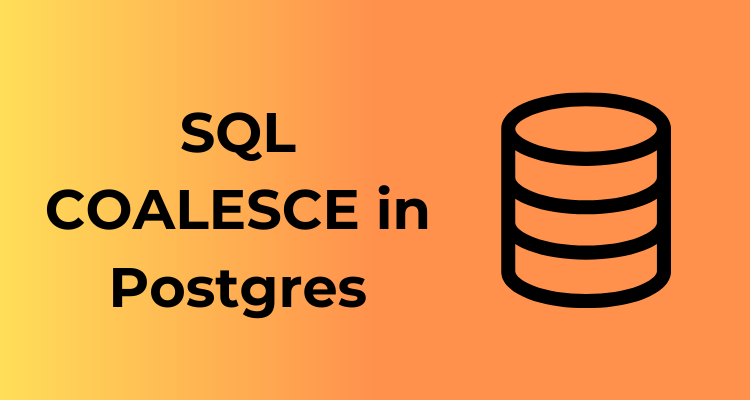If you’ve ever had to deal with missing data in your PostgreSQL database, you’ll know how frustrating it can be. Enter: COALESCE, one of the most versatile and handy SQL functions out there. But, what exactly is COALESCE, and why should you care about it? Let’s dive into the basics!
COALESCE is a SQL function that helps you elegantly handle NULL values in your database. Simply put, it takes a list of arguments and returns the first one that isn’t null. It’s like giving your query a decision-making superpower. If the first value is null, it moves on to the next one—and keeps going until it finds something with actual data. If all the arguments are null (which, let’s face it, happens in some messy databases), COALESCE will return null.
Why is COALESCE Valuable?

NULLs are a necessary part of any database—for example, you might have incomplete user profiles or optional columns that are intentionally left blank. However, they can wreak havoc on calculations, reports, or even user-facing applications when not handled properly. By using COALESCE, you can define default values or fallbacks that prevent your query results from turning into a mess.
Key Advantages of Using COALESCE
- Simplicity: The COALESCE function is easy to use and avoids the need for longer, more cumbersome conditional logic.
- Readability: Queries with COALESCE are easier to read compared to complex nested conditional statements, making teamwork on databases far smoother.
- Efficiency: It looks at each argument one-by-one and stops as soon as it finds a non-null value, saving processing time.
Breaking It Down with an Example
Let’s say you have a table with customer information in it. Some customers have provided their email, others their phone, and some neither. You want to prioritize using email, followed by phone, and lastly, use a placeholder like “No Contact Info” if both are missing. Instead of writing a cumbersome query, here’s how COALESCE comes to the rescue:
SELECT name,
COALESCE(email, phone, 'No Contact Info') AS contact_info
FROM customers;
What happens here is magical—PostgreSQL will check the first column (email), and if it’s null, will move on to the next column (phone). If both email and phone are null, it defaults to the text string “No Contact Info.” Isn’t that neat?
When to Use COALESCE
You’ll most often use COALESCE when you need to:
- Handle nullable columns in a database.
- Provide fallback options in queries.
- Make reports or analytics more user-friendly by avoiding NULL results.
The best part? COALESCE works with multiple data types, so whether you’re handling integers, text, dates, or even complex expressions, it’s your go-to tool. It’s truly a Swiss Army knife for null-handling.
Now that you’ve got a handle on what COALESCE is and why it’s helpful, you’re ready to tackle more complex use cases. Stay with me for the next sections where we’ll dive into syntax, practical examples, and even advanced tips to supercharge your SQL skills!
The Syntax of COALESCE Made Effortless

When it comes to the SQL COALESCE function in Postgres, understanding its syntax can be your golden ticket to writing cleaner and more effective SQL queries. Despite how powerful it is, the syntax itself is refreshingly simple, which makes it an essential tool for developers and analysts alike. Let’s break it down in a way that’s both approachable and practical.
What Does the Syntax Look Like?
At its core, the COALESCE function has a very straightforward syntax:
COALESCE(value1, value2, ..., value_n)
Here’s what happens: COALESCE will evaluate each value in the list, one by one, from left to right. The function will return the first non-NULL value it encounters. If all the values happen to be NULL, then the entire function itself returns NULL.
Pro tip: The number of values you can supply to COALESCE is essentially unlimited, which makes it super flexible. You could pass two values or twenty—it works the same!
Breaking It Down
If syntax diagrams sound intimidating, don’t worry! Let’s demystify it with a practical verbal explanation:
- Start with the function name
COALESCE. - Inside the parentheses, provide a comma-separated list of values or columns you want to evaluate. These could be actual data values, column names, or even expressions.
- As soon as the function finds a value that isn’t
NULL, it stops and returns that value.
For example, if you have a column that sometimes contains NULL but you want to provide a fallback value instead, COALESCE can step in like your SQL superhero.
A Quick Syntax Example
Let’s say you have a table called employees, with a column named middle_name. If a person doesn’t have a middle name (stored as NULL), you want to display ‘N/A’ instead. The query would look like this:
SELECT
first_name,
COALESCE(middle_name, 'N/A') AS middle_name,
last_name
FROM employees;
Here, COALESCE checks middle_name. If it’s NULL, it falls back to the second argument, 'N/A'. Easy, right?
Conditions and Nesting
Fun fact: COALESCE can work with different data types, as long as they are compatible (e.g., strings with strings, numbers with numbers). And for more advanced use, you can even nest it within other SQL functions. Don’t worry, we’ll leave the fancy combinations for future sections!
While COALESCE doesn’t replace all conditional logic in SQL (other tools like CASE might be more appropriate in some scenarios), it shines when dealing with NULL values and providing a clear fallback.
Why You Should Love COALESCE
If you’re someone who values clarity and elegance in your queries, COALESCE allows you to handle missing values with minimal effort. The syntax is compact yet expressive—no need for verbose IF or CASE statements when all you want is a simple default value mechanism. It doesn’t just make your life easier; it also makes your code more readable for others!
Now that you understand how effortless COALESCE’s syntax is, you’re ready to incorporate it into your queries like a pro. But wait—there’s more! Once you’ve mastered the basics of the syntax, you’ll discover just how much it can simplify your work when dealing with real-life data scenarios. Stay tuned for those examples and tricks ahead!
Handling Nulls with COALESCE: Real-Life Examples
Ah, the dreaded NULL – the ultimate “neither-here-nor-there” in the PostgreSQL world. If you’ve ever wrestled with NULL values in your database, don’t worry – you’re not alone. Lucky for us, PostgreSQL’s COALESCE function is here to help! This wonderful function turns the chaotic uncertainty of NULLs into something structured and, well, much more manageable.
What Does COALESCE Do With NULL?
Before diving into examples, let’s make sure we’re on the same page. The COALESCE function allows you to handle NULL values by providing it with a list of potential fallback values. It essentially says, “Hey, use the first non-NULL value you find in this list.” If all the values in the list are NULL? Well, COALESCE lets you down gently by simply returning NULL.
Why Should We Care About NULLs?
In many real-world databases, NULLs commonly arise in incomplete datasets. Imagine a customer database where some users haven’t provided their phone numbers or email addresses. Without proper handling, these missing values can muddy queries, cause errors, or even distort reports. COALESCE ensures that your queries stay sane and elegant, even in a messy data situation.
Real-Life Examples (Brace Yourself for Simplicity)
1. Replacing NULL with a Default Value
Say you have a table of customers, but not all of them have filled out the “city” column. You want to ensure your query always returns something. Here’s how to use COALESCE:
SELECT customer_name, COALESCE(city, 'Unknown') AS location
FROM customers;
Here, any NULL value in the city column will magically turn into ‘Unknown’. No more confusion!
2. Combining Columns for a Full Picture
Let’s take it a step further. Imagine a scenario where you have two columns for contact info – phone_number and email. If one of these is missing, you still need at least one form of contact. COALESCE can help:
SELECT customer_name, COALESCE(phone_number, email, 'No Contact Information') AS contact_info
FROM customers;
Look at that! You’ve created a prioritized fallback chain. If phone number is NULL, email is used. If both are NULL, the string ‘No Contact Information’ is returned.
3. Calculating Totals with Optional Data
Imagine a sales report where not all discounts are recorded – some might be NULL. Using COALESCE ensures that those NULLs don’t mess up your totals:
SELECT item_id, price - COALESCE(discount, 0) AS final_price
FROM sales;
Here, discounts default to 0 if they’re missing, keeping your final price calculations correct.
Pro Tips for COALESCE Data Wizardry
- Order matters: COALESCE evaluates values in the order they’re listed. Make sure high-priority values appear first.
- Match data types: All COALESCE arguments must share the same data type, or you risk errors.
- NULL-safe! Unlike manually checking values with IF statements, COALESCE simplifies and streamlines.
Comparing COALESCE with IF-THEN and CASE Statements
Let’s dive into a topic that often stirs a bit of curiosity: the difference between COALESCE, IF-THEN, and CASE statements in PostgreSQL. Each of these approaches serves a similar purpose — they allow us to handle conditional logic in our SQL queries. However, the way they operate and their areas of strength differ. Let’s make this crystal clear with some friendly explanations and advice!
What Exactly Does COALESCE Do?
COALESCE is like your go-to friend who always falls back on Plan B when Plan A doesn’t work out. It evaluates a list of arguments from left to right and returns the first non-NULL value it finds. Simple, right? It’s your buddy for null-value-handling, especially when you want a single, clean approach to ensure your data doesn’t leave you hanging with blanks.
How Does IF-THEN Differ?
The IF-THEN construct is more procedural and straightforward. Imagine writing step-by-step instructions for every possible outcome. It’s not natively used within PostgreSQL’s SQL queries but is prominent in procedural scripting using PL/pgSQL. For example:
IF condition THEN
-- do something
ELSE
-- do something else
END IF;
While this logic is structured and easy to follow, it can get verbose in certain cases. You’d typically use IF-THEN in stored procedures or functions rather than as an inline way to handle nulls or alternative values for columns in a table.
And What About CASE Statements?
CASE statements shine when you need more flexibility and want to handle multiple conditions. Consider them the chameleons of SQL—adaptable but a little more verbose. For example:
CASE
WHEN condition1 THEN result1
WHEN condition2 THEN result2
ELSE result_default
END
This is incredibly useful when you want to evaluate complex logic, but in terms of null handling, CASE might feel like overkill for straightforward needs.
COALESCE vs IF-THEN vs CASE: When Should You Choose Each?
- Use
COALESCEwhen: You want a clean, concise way to deal with potentialNULLvalues. It’s lightweight, built specifically for null checking, and excels in inline SQL usage to ensure your queries return meaningful data. - Use
IF-THENwhen: You’re defining procedural logic in functions or scripts, and step-by-step logic is necessary. It’s great for more procedural control but not ideal for one-off inline handling. - Use
CASEwhen: You need to evaluate multiple conditions beyond nulls. For example, performing calculations based on multiple criteria makesCASEindispensable.
The Verdict: COALESCE Is Your Top Pick for Simplicity
If your primary goal is handling nulls and ensuring your data remains user-friendly and coherent, COALESCE is the hero. It’s efficient, easy to use, and designed specifically for this purpose. However, don’t be shy about reaching for CASE or IF-THEN when your logic demands it.
The beauty of PostgreSQL lies in its flexibility. Be intentional with the tools you use, and you’ll find crafting SQL queries becomes less about ‘fixing’ and more about creating elegant solutions.
“`
Performance Insights: When to Use and When to Avoid
Let’s talk about the big elephant in the room: performance. The COALESCE function is awesome for handling NULL values in PostgreSQL, but like any other tool in your SQL toolbox, there are moments where it shines and others where it might drag you down. Before you go crazy sprinkling it everywhere in your queries, let’s dive into some essential performance insights to ensure you’re using it thoughtfully and effectively. Shall we?
When You Should Definitely Use COALESCE
Here are scenarios where COALESCE is a superstar:
- Default Values: If you’re handling data that might have
NULLvalues,COALESCEis the go-to feature to assign those values a default. For example, if you’re calculating profits and some cells in your revenue data are missing, the function can substitute zero without breaking your calculations. - Data Presentation: When generating reports or user-facing data,
NULLvalues can confuse and clutter. For instance, presenting a blank name or income field can mislead your users. UsingCOALESCE, you can provide fallback text like “Unknown” or “N/A” for readability. - Cleaning Up Queries: Nested
IFstatements can make queries messy and hard to debug. UsingCOALESCEmakes your code much cleaner and easier to maintain when dealing withNULL.
In these cases, COALESCE not only simplifies expressions but also helps applications stay robust and end-user friendly. A little foresight here can significantly improve your database application’s output.
When You Should Be Cautious With COALESCE
While COALESCE is incredibly handy, there are also situations where overusing or misusing it can backfire. Let’s take a closer look:
- Consider Index Impact: If you are using
COALESCEon a column that is part of an index, you might unintentionally disable PostgreSQL’s ability to use that index for searching. This happens because the transformed value (e.g., a default you set withCOALESCE) is not a direct match to the indexed entries. - Big Datasets and Complex Queries: On very large tables or in deeply nested queries, frequent use of
COALESCEcan potentially slow things down. While PostgreSQL is efficient, every field processed byCOALESCEadds a bit of computational overhead. Overuse on massive datasets can harm query performance. - Logical Errors: Be careful about unintended logic errors! For example, using
COALESCE(some_column, '')could lead to unexpected results when empty strings andNULLvalues aren’t actually equivalent in your data’s context.
A key takeaway here? Use COALESCE sparingly and only in places where it actually adds value without adding unnecessary cost.
Pro Tips for Keeping COALESCE Fast
- Index Carefully: If you’re relying heavily on
COALESCE, consider whether your indexes need adjustment to accommodate the transformed results. However, beware—it might not always be worth maintaining indexes on derived values. - Test Your Query Plans: Always analyze the query execution plan (using
EXPLAINorEXPLAIN ANALYZE) to ensureCOALESCEisn’t introducing inefficiencies. - Know Your Dataset: Before using
COALESCE, check whether your data actually hasNULLvalues. If it doesn’t, you’re better off leaving it out. - Stay Consistent: If multiple developers are contributing to your queries, establish consistent rules around when and how to use
COALESCEto avoid confusion in collaborative environments.
Practical Use Cases You Might Not Have Considered
When it comes to practical applications of COALESCE, many people only scratch the surface. It’s often viewed as a way to handle null values, but its versatility extends beyond replacing nulls with default values! Let’s dive into some lesser-known yet handy use cases to supercharge your PostgreSQL queries.
1. Simplifying Data Aggregation
Ever needed to calculate totals or averages but discovered pesky nulls skewing your results? COALESCE can come to the rescue! For example, when aggregating sales figures, nulls usually mean no sales were made, and you want to treat them as zeros:
SELECT product_id,
SUM(COALESCE(sales_amount, 0)) AS total_sales
FROM sales_data
GROUP BY product_id;This simple query ensures that your sums ignore nulls and treat them as zero, providing accurate totals.
2. Generating User-Friendly Output
Have you ever delivered SQL query outputs that didn’t quite make sense to your end users because of blank fields? Replace those blanks with meaningful placeholders using COALESCE. For instance, when building a user report:
SELECT user_id,
COALESCE(first_name, 'Unknown') AS display_name
FROM users;Now, instead of showing an empty value or blank space when someone’s first name is null, the output will display “Unknown,” making it more user-friendly.
3. Versatile Data Transformation
Are you working on ETL (Extract, Transform, Load) tasks or cleaning up data for further processing? COALESCE lets you transform data effortlessly. Suppose you’re consolidating multiple address fields into a single column:
SELECT user_id,
COALESCE(address1, address2, address3, 'No Address Available') AS full_address
FROM users;This example checks multiple columns in sequence and grabs the first non-null value. If all fields are null, it uses a default string, ensuring every user has a usable “full_address.”
4. Dealing with Optional Input in Queries
Sometimes, optional parameters in queries can make building dynamic SQL tricky. Enter COALESCE. It’s the perfect ally for handling user-input filters in WHERE clauses:
SELECT *
FROM orders
WHERE order_date >= COALESCE(:start_date, CURRENT_DATE - INTERVAL '30 days');With this setup, if a user doesn’t provide a filter for start_date, it conveniently defaults to 30 days prior to today. Bam! No need for messy conditional logic.
5. Creating Concatenated Fields
Need to combine multiple fields into a single string but some columns might be null? COALESCE plays nicely with concatenation:
SELECT user_id,
COALESCE(first_name, '') || ' ' || COALESCE(last_name, '') AS full_name
FROM users;This query ensures that there are no ugly “null” strings in the generated full_name output. If a user has only one name available, the result still looks clean.
Why These Scenarios Matter
What makes all these use cases brilliant is COALESCE‘s blend of simplicity and power. It allows you to handle edge cases gracefully, structure your data intuitively, and save yourself from writing complex, conditional logic. Its concise syntax often results in more readable and maintainable SQL.
Advanced Queries: Combining COALESCE with Other SQL Functions
Ready to level up your SQL game? Let’s dive into the exciting world of combining COALESCE with other SQL functions. Whether you’re optimizing data retrieval or building powerful queries, this advanced approach will take you one step closer to becoming a SQL wizard. Don’t worry—I’ll guide you every step of the way!
1. Enhancing Aggregations with COALESCE
Aggregation functions like SUM, AVG, and COUNT are central to most SQL queries. But these functions can falter when encountering NULL values. That’s exactly where COALESCE shines!
For instance, consider calculating the total revenue of a product. If there are missing (i.e., NULL) values in the revenue column, you can use COALESCE to substitute them with a default, like zero, ensuring your total revenue doesn’t get skewed:
SELECT
SUM(COALESCE(revenue, 0)) AS total_revenue
FROM
sales_data;
Here, COALESCE(revenue, 0) replaces any NULL values with zero before summing. This ensures accuracy, while also maintaining clarity in your query.
2. Using COALESCE with String Manipulation Functions
Now let’s move into text data. Handling NULL in string columns can be tricky, especially when concatenating or manipulating text. However, with COALESCE, you can define fallback values to keep your strings error-free.
Say, you want to create a full name by combining first and last names, but some rows are missing one part. Instead of having undefined or awkward outputs, you can use COALESCE:
SELECT
COALESCE(first_name, 'Unknown') || ' ' || COALESCE(last_name, 'Name Missing') AS full_name
FROM
users;
This query fills in placeholder text like “Unknown” or “Name Missing” if first or last names are NULL. It ensures the generated full_name is always meaningful!
3. Dynamic Date Handling
Dates and timestamps are another area where COALESCE can be incredibly helpful. Imagine you’re working with an events table and want to sort events by their actual date, but some records only have a fallback placeholder date.
You can handle this effortlessly as follows:
SELECT
event_name,
COALESCE(event_date, placeholder_date) AS final_event_date
FROM
events
ORDER BY final_event_date;
By using COALESCE, the query selects the true event date if available. Otherwise, it neatly falls back to the placeholder date, providing a seamless experience in handling incomplete data.
4. Combining COALESCE and Subqueries
This is where things get even more exciting! You can nest subqueries inside COALESCE for dynamic fallback logic. For example:
SELECT
user_id,
COALESCE(
(SELECT preferred_language FROM user_preferences WHERE user_id = users.id),
'en'
) AS language
FROM
users;
In this query, COALESCE first attempts to retrieve a user’s preferred language from the user_preferences table. If no preference exists, it defaults to ‘en’ (English). Pretty slick, right?
Pro-Tip: Balance Complexity and Clarity
While combining COALESCE with other functions is powerful, be mindful of query readability. If a query becomes too complex, consider breaking it into smaller steps or using WITH statements (Common Table Expressions). Maintain a balance between sophistication and clarity, so your future self—or your teammates—can easily understand your work later.
Why This Matters
Combining COALESCE with other SQL functions adds layers of robustness and flexibility to your queries. Not only does it ensure your output is clean and meaningful, but it also prepares you to handle messy, real-world data gracefully.









